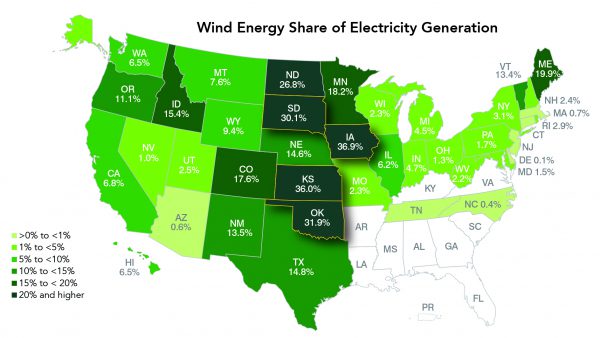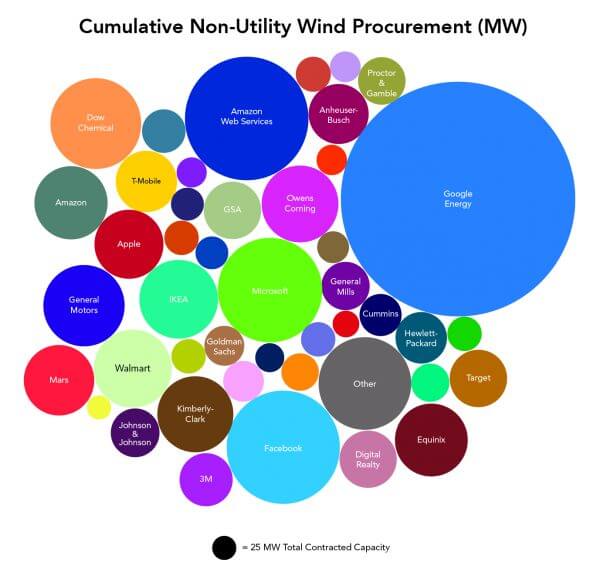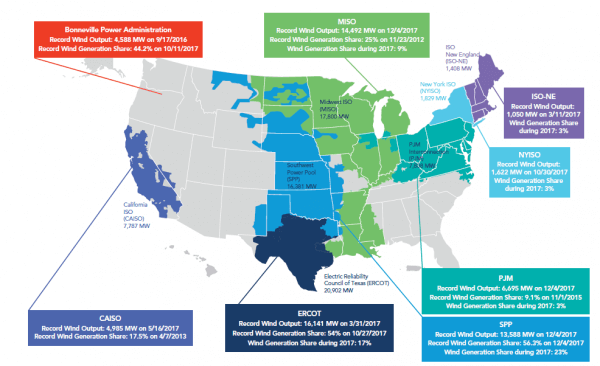Editor’s note: This blog post comes from the American Wind Energy Association’s (AWEA) Into the Wind blog. It was written by John Hensley, AWEA’s lead on industry data and analysis. You can read AWEA’s other blog postings here.
 AWEA recently released its 2017 Annual Market report, and it’s full of new data and positive industry trends observed over the past year. There’s a lot of good news to share, and the full report is definitely worth a read, but here are a few key takeaways you need to know:
AWEA recently released its 2017 Annual Market report, and it’s full of new data and positive industry trends observed over the past year. There’s a lot of good news to share, and the full report is definitely worth a read, but here are a few key takeaways you need to know:
1. More families & businesses than ever are powered by wind
Iowa, Kansas, South Dakota and Oklahoma have all achieved a significant milestone: they all now generate at least 30% of their electricity using wind power. That offers clear proof that wind can reliably satisfy a large portion of electricity demand. Overall, 14 states generate at least 10% of their electricity using wind, including Texas, the country’s largest energy consumer and producer.
The U.S. now has enough installed wind capacity to power the equivalent of 27 million American homes.
2. A new entrant moves up the leaderboard
Texas continues to have far and away the most installed wind capacity, followed by Oklahoma and Iowa. But a new state is quickly moving up the wind rankings: New Mexico. In 2017, New Mexico had the highest rate of new wind growth, and it now has enough installed capacity to power the equivalent of over half a million homes. The state also has several significant projects under construction or in advanced development, so New Mexico could quickly find itself becoming a wind powerhouse.
And that brings new opportunities to the state. For example, recently Facebook decided to expand a New Mexico data center specifically because it could power the facility using wind energy.
 Speaking of brands buying wind…
Speaking of brands buying wind…
3. Fortune 500’s, cities & universities keep buying wind
Now a firmly established trend, non-utility wind deals continued at a healthy rate. In 2017 alone, these buyers signed 23 contracts for wind energy. Notable deals include agreements by GM, Anheuser-Busch, Amazon, Google and General Mills, among others.
4. Wind brings farming and factory towns new opportunities
In 2017 alone, farmers and ranchers were paid $267 million in lease payments for hosting turbines. That’s income they can count on during times of drought or fluctuating commodity prices. Even better, that number will only continue to grow as America’s large wind development pipeline starts coming online.
Check out this video for a look at what that can mean for farming towns.
5. Better technologies mean more wind production
Wind technology has continued to progress at an impressive rate, and results from wind farms built over the last several years show the impact of those advances. Wind projects that came online between 2014 and 2016 have averaged capacity factors over 40%, a figure that nears some conventional power plants. Because new technology lets these projects reach stronger, steadier winds, they generate more electricity at a lower cost.
It’s a big reason why wind is now 67% cheaper than it was in 2009, and it has also allowed wind to expand into new states like North Carolina, and soon, Arkansas.

View an enlarged image of the map here.
6. Wind sets records
Each and every one of the seven Regional Transmission Organizations and Independent System Operators set a new wind generation record in 2017. ERCOT, the grid operator for most of Texas, set the record for most wind-power generation at a single point in time as wind turbines delivered 16,141 MW on March 31, 2017.
To the North, the Southwest Power Pool (SPP) saw wind meet 56% of electricity demand for a period on December 4, 2017 – a record for any organized market.
These increasingly high wind output and penetration rates demonstrate the ability of system operators to efficiently integrate wind power onto the grid and reliably deliver electricity. In fact, during all of 2017, SPP saw wind deliver 23% of all electricity generated in the market—another record-setting achievement.
AWEA’s Annual Market report is full of other useful information. Get more details here. You can also review the top facts and trends in the Executive Summary here.
Filed Under: News, Policy, Projects




